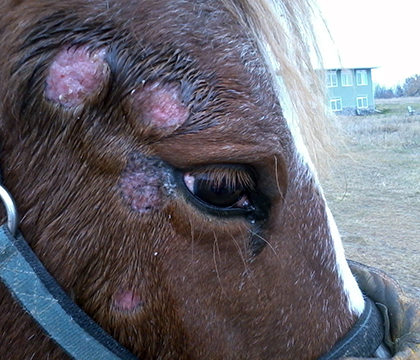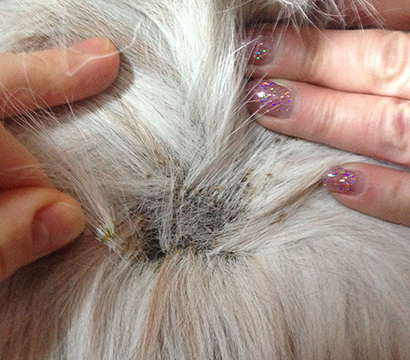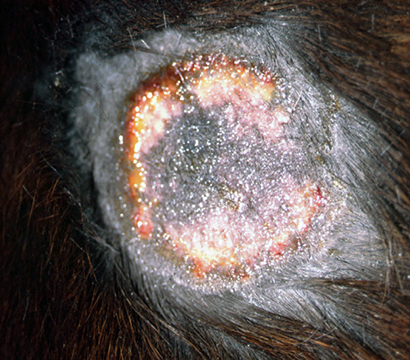
Scratching the surface of equine skin diseases
If you have ever owned a horse with a skin disease, you know from experience that these conditions are frustrating to manage — diagnosing them can be difficult and their treatment is tedious. Worse yet, skin diseases can be painful for your horse if they cause irritation under tack or lameness.
By Hayley Kosolofski
Dr. Michelle Husulak has seen her fair share of equine skin diseases during her work as a resident in equine field service at the Western College of Veterinary Medicine's Veterinary Medical Centre. Husulak talks about diagnosing and treating four of the most common skin conditions that plague horses in Western Canada.
Pastern Dermatitis
Pastern dermatitis goes by many names: scratches, grease heel, cracked heel or mud fever. Veterinarians can rarely identify the cause of the disease, but the main suspects are bacteria and fungus.
Crusted scabs are typically found on the back of the pastern, but lesions can extend higher or to the front of the leg. The condition most often affects white areas on a horse's leg, and it can be aggravated by sunlight. To make matters worse, the limb is often swollen and painful.
"The skin below the crusting is red and cracked and there is often hair loss there as well," says Husulak.
She says it's important to talk to your veterinarian early in the disease process. If they see the wounds in the early stages, they can biopsy the skin to try to determine the cause and treat your horse more effectively.
"Initially, we start off by clipping the hair and removing the dirt and debris. Then we remove the crusts with warm water and anti-bacterial soap," says Husulak. She adds that this process can be painful, and the horse may need to be sedated.
"We then apply a scratches ointment that's made by our pharmacy," says Husulak. "It contains steroid, antibiotic and antifungal medication that decreases the inflammation and kills bacteria and fungi present in the skin."
The leg is then bandaged to keep it clean and out of the sun. Owners must continue to clean the sores, apply cream and bandage the leg daily until the wounds heal.

Dermatophilosis
Dermatophilosis, also known as rain rot or rain scald, is a disease of moist conditions. It's often seen in wet climates or under winter blankets when horses sweat.
Dermatophilosis is caused by a contagious bacteria called Dermatophilus congolensis. It can be spread between horses on brushes and tack — or by biting insects. Dermatophilosis also affects other animals, such as cattle, but it's rarely diagnosed in people.
"This disease doesn't commonly affect completely healthy horses. There needs to be a break in the skin, and usually, the horse has an underlying condition that decreases its ability to fight off the infection," says Husulak. Cracks in a horse's skin can be caused by superficial wounds from trees, fences or other horses.
"The main clinical sign is a crusting or ‘paint brush' lesion," says Husulak. Discharge and pus stick in the hair next to the skin and create paint brush-like tufts when they fall out. These tufts leave behind a patch of bald skin and become a source of infection for other animals.
Typically, a horse is diagnosed with dermatophilosis based on the clinical signs. In abnormal cases, a sample of skin from affected areas can be sent to the lab for confirmation.
"For treatment, the most important thing is to attempt to keep the horse dry," says Husulak. In the winter, this may mean moving the horse into the barn so its blanket can be removed.
She adds that the crusts need to be removed and the horse's skin must be cleaned with anti-bacterial soap. If lesions are small, you or your veterinarian can apply a topical antibiotic. But for more widespread disease, oral or injectable antibiotics may be necessary to treat the whole horse.

Dermatophytosis
Dermatophytosis or ring worm is a highly contagious fungal disease that affects horses, humans and other animals. Horses are most often infected with the fungus, Trichophyton equinum, which is less likely to infect people. Microsporum equinum also causes ring worm and is contagious to people.
Dermatophytosis is easily spread between horses by direct contact or contaminated objects such as tack, brushes and fence posts. That's why disinfecting your barn or arena is an important part of controlling this disease.
"We usually see circular patches of hair loss with scaling or crusting within them," describes Husulak. "Usually these lesions start out small, and the crusting will spread out. A bald patch will be present in the middle of the lesion."
The horse's face, neck and girth are the most common areas to be affected, but lesions can cover the whole horse in severe cases. Since many diseases can imitate dermatophytosis, veterinarians rely on a fungal culture to confirm the diagnosis.
"For treatment, we like to apply a topical antifungal cream every 12 hours to kill off the fungus," says Husulak. If there are more widespread lesions, she recommends using an antifungal rinse that can poured onto the horse. In chronic cases, your veterinarian may decide to give oral antifungal medication to the patient.
Husulak says horses develop some immunity after a dermatophytosis infection. If a horse is re-infected, it could be a different species of fungus involved or an underlying problem that's causing immunosuppression in the animal's body.
Urticaria
Urticaria or hives is a skin reaction to allergies or to other stressors. The reaction causes flat-topped wheals (raised areas surrounded by a red base) that can vary in size. In most cases, these wheals are not painful or itchy.
"This is usually an allergic reaction to food, drugs, vaccines or anything that the horse is exposed to and may be allergic to," says Husulak. "It can also be caused by non-allergic reactions such as heat, cold, exercise or stress."
Finding the cause of urticaria can be difficult. "We ask questions about the horse's history and try to find out if they have been recently vaccinated or treated with any drugs, or if there has been a recent change in their environment or feed," says Husulak. But in many cases, the cause of the skin reaction can't be identified.
Veterinarians can perform allergy testing to try and determine the cause of the urticaria. However, this is often unrewarding as the allergens that are tested are usually different from the ones that are present in the horse's environment.
"When we are trying to treat this, we attempt to treat the symptoms — the swellings that are happening on the body. These are usually treated with steroids," says Husulak.
Urticaria is often a one-time event, but if the condition recurs or is severe, it's important to try and determine the cause to prevent subsequent allergic reactions, says Husulak.
Hayley Kosolofski of Sherwood Park, Alta., is a fourth-year veterinary student at the Western College of Veterinary Medicine (WCVM). Republished with permission from Canadian Horse Journal (horsejournals.com).
Pastern Dermatitis
Pastern dermatitis goes by many names: scratches, grease heel, cracked heel or mud fever. Veterinarians can rarely identify the cause of the disease, but the main suspects are bacteria and fungus.
Crusted scabs are typically found on the back of the pastern, but lesions can extend higher or to the front of the leg. The condition most often affects white areas on a horse's leg, and it can be aggravated by sunlight. To make matters worse, the limb is often swollen and painful.
"The skin below the crusting is red and cracked and there is often hair loss there as well," says Husulak.
She says it's important to talk to your veterinarian early in the disease process. If they see the wounds in the early stages, they can biopsy the skin to try to determine the cause and treat your horse more effectively.
"Initially, we start off by clipping the hair and removing the dirt and debris. Then we remove the crusts with warm water and anti-bacterial soap," says Husulak. She adds that this process can be painful, and the horse may need to be sedated.
"We then apply a scratches ointment that's made by our pharmacy," says Husulak. "It contains steroid, antibiotic and antifungal medication that decreases the inflammation and kills bacteria and fungi present in the skin."
The leg is then bandaged to keep it clean and out of the sun. Owners must continue to clean the sores, apply cream and bandage the leg daily until the wounds heal.

Dermatophilosis
Dermatophilosis, also known as rain rot or rain scald, is a disease of moist conditions. It's often seen in wet climates or under winter blankets when horses sweat.
Dermatophilosis is caused by a contagious bacteria called Dermatophilus congolensis. It can be spread between horses on brushes and tack — or by biting insects. Dermatophilosis also affects other animals, such as cattle, but it's rarely diagnosed in people.
"This disease doesn't commonly affect completely healthy horses. There needs to be a break in the skin, and usually, the horse has an underlying condition that decreases its ability to fight off the infection," says Husulak. Cracks in a horse's skin can be caused by superficial wounds from trees, fences or other horses.
"The main clinical sign is a crusting or ‘paint brush' lesion," says Husulak. Discharge and pus stick in the hair next to the skin and create paint brush-like tufts when they fall out. These tufts leave behind a patch of bald skin and become a source of infection for other animals.
Typically, a horse is diagnosed with dermatophilosis based on the clinical signs. In abnormal cases, a sample of skin from affected areas can be sent to the lab for confirmation.
"For treatment, the most important thing is to attempt to keep the horse dry," says Husulak. In the winter, this may mean moving the horse into the barn so its blanket can be removed.
She adds that the crusts need to be removed and the horse's skin must be cleaned with anti-bacterial soap. If lesions are small, you or your veterinarian can apply a topical antibiotic. But for more widespread disease, oral or injectable antibiotics may be necessary to treat the whole horse.

Dermatophytosis
Dermatophytosis or ring worm is a highly contagious fungal disease that affects horses, humans and other animals. Horses are most often infected with the fungus, Trichophyton equinum, which is less likely to infect people. Microsporum equinum also causes ring worm and is contagious to people.
Dermatophytosis is easily spread between horses by direct contact or contaminated objects such as tack, brushes and fence posts. That's why disinfecting your barn or arena is an important part of controlling this disease.
"We usually see circular patches of hair loss with scaling or crusting within them," describes Husulak. "Usually these lesions start out small, and the crusting will spread out. A bald patch will be present in the middle of the lesion."
The horse's face, neck and girth are the most common areas to be affected, but lesions can cover the whole horse in severe cases. Since many diseases can imitate dermatophytosis, veterinarians rely on a fungal culture to confirm the diagnosis.
"For treatment, we like to apply a topical antifungal cream every 12 hours to kill off the fungus," says Husulak. If there are more widespread lesions, she recommends using an antifungal rinse that can poured onto the horse. In chronic cases, your veterinarian may decide to give oral antifungal medication to the patient.
Husulak says horses develop some immunity after a dermatophytosis infection. If a horse is re-infected, it could be a different species of fungus involved or an underlying problem that's causing immunosuppression in the animal's body.
Urticaria
Urticaria or hives is a skin reaction to allergies or to other stressors. The reaction causes flat-topped wheals (raised areas surrounded by a red base) that can vary in size. In most cases, these wheals are not painful or itchy.
"This is usually an allergic reaction to food, drugs, vaccines or anything that the horse is exposed to and may be allergic to," says Husulak. "It can also be caused by non-allergic reactions such as heat, cold, exercise or stress."
Finding the cause of urticaria can be difficult. "We ask questions about the horse's history and try to find out if they have been recently vaccinated or treated with any drugs, or if there has been a recent change in their environment or feed," says Husulak. But in many cases, the cause of the skin reaction can't be identified.
Veterinarians can perform allergy testing to try and determine the cause of the urticaria. However, this is often unrewarding as the allergens that are tested are usually different from the ones that are present in the horse's environment.
"When we are trying to treat this, we attempt to treat the symptoms — the swellings that are happening on the body. These are usually treated with steroids," says Husulak.
Urticaria is often a one-time event, but if the condition recurs or is severe, it's important to try and determine the cause to prevent subsequent allergic reactions, says Husulak.
Hayley Kosolofski of Sherwood Park, Alta., is a fourth-year veterinary student at the Western College of Veterinary Medicine (WCVM). Republished with permission from Canadian Horse Journal (horsejournals.com).
